Energy labelling measures for household laundry tumble dryers (TD) were first introduced in 1995. They were updated and complementary Ecodesign measures were introduced in 2012.
There are two main types of TD: Air-vented dryers and Condenser dryers.
Air-vented dryers draw air from the room in which they are installed, heat it and lead it through the humid clothing in the drum to evaporate the moisture. The humid air is then expelled to the external environment. Air-vented dryers thus require an exhaust to the outside, making them less practical.
Condenser dryers use a similar process but have an additional heat exchanger to cool the humid air, thus condensing the water. The liquid water is stored in a tray or fed into the drain. Condenser dryers do not require an exhaust to the outside, but due to the additional components they are more costly. Condensing requires additional energy, but the technology has the potential for efficiency improvement by heat recovery from the outgoing air (when applying heat pump technology).
Scope
The following table shows some examples of products in scope and out of scope
| In Scope | Out of Scope |
|---|---|
|
|
Check the complete list in the Regulation.
Ecodesign Requirements
Ecodesign requirements apply to household tumble dryers sold in the EU. These requirements cover energy efficiency, energy consumption in low power modes, condensation efficiency, resource efficiency and product information. Ecodesign requirements set minimum energy efficiency thresholds so that only products meeting those thresholds can be placed on the market. On 1 July 2025, date of entry into application of Regulation (EU) 2023/2533, only tumble dryers featuring the most efficient heat pump technology, which also makes them more economical in terms of running costs, will be allowed on the Union market .
Energy Label
Regulation (EU)2023/2534 has fully reviewed the energy label in order to reflect the overall improvements on household tumble driers energy efficiency over the last years. Until 30 June 2025, tumble dryers will continue to be supplied with an energy label showing their energy efficiency rating on a scale from A+++ to D, differentiated for electric air-vented, gas air-vented and electric condenser appliances. However as from 1 July 2025, energy labels rating tumble driers’ energy efficiency on an A to G scale must be displayed in shops and online.
| Current Tumble Dryer Energy Label | |
|---|---|
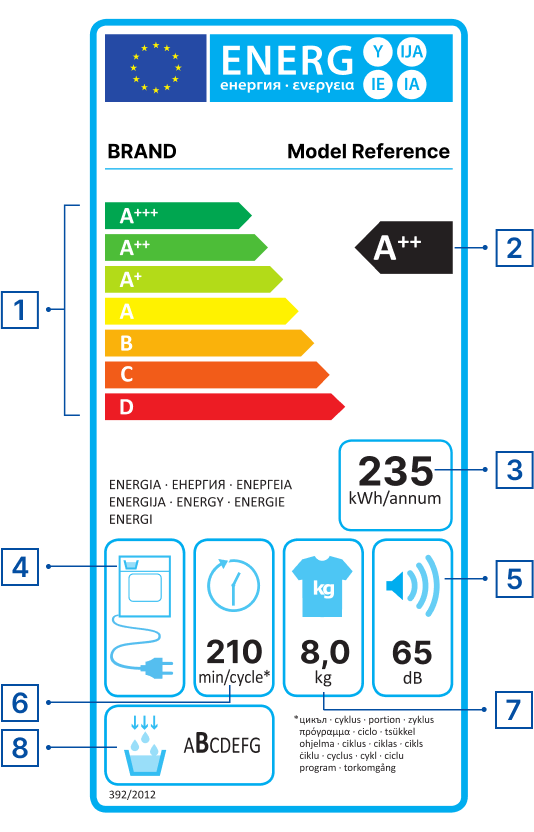 |
|
| Future Tumble Dryer Energy Label (as of 1 July 2025) | |
|---|---|
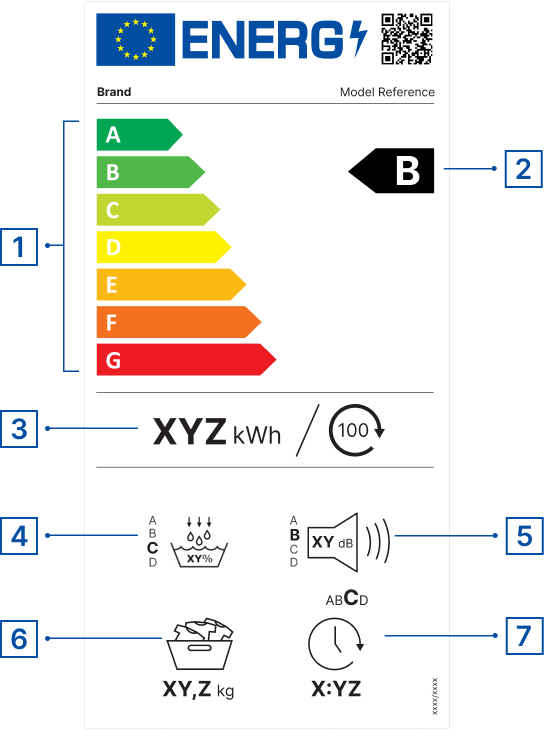 |
|
Eco-Tips and Tricks
- Select the correct drying level (e.g. cupboard dry) instead of a drying time. This will prevent overdrying and increased energy consumption. The right drying level in addition also avoids the shrinking and creasing of laundry.
- Dry similar laundry together even if different degrees of dryness might be required. If that is the case, first select a more humid drying level (e.g. iron dry) and remove that part of the laundry at the end of the program. Then continue with a new drying cycle with a different degree of dryness, e.g. cupboard dry.
- If you can, use a drying rack instead of a tumble dryer.
- If possible, dry the recommended nominal load (dry weight). Overloading and underloading are not advisable in terms of energy consumption.
- Clean all filters and components at least according to the manufacturer's recommendations. Depending on the model, it might self-clean both the lint filter and/or the condenser. Clean according to the information in the User Manual.
- Ensure adequate ventilation at the tumble dryer's installation site. The ambient temperatures should not rise too high.
- Use the maximum recommended spin speed to extract moisture from the laundry. Mechanical water removal is much more energy efficient. The initial moisture content has an obvious influence on the energy required for drying
- If you have a very old tumble dryer, take a look at the electricity consumption, it may be worth replacing the appliance long before it is ready for disposal.
- If the laundry are tangled after getting from washing machine, it would be better to separate the laundry from each other and thrown into the dryer for fine drying performance.
Highlights
Household tumble dryers are subject to EU energy labelling and ecodesign requirements. Switching to one of the most efficient tumble dryers can reduce energy consumption by around 60%. With more efficient tumble dryers, Europe will be able to save up to 15 TWh of electricity between 2020 and 2040, equivalent to 2.5 times the annual final energy consumption of Malta.
Facts & Figures
This graphic shows the estimated sales, stock, energy consumption (primary, electric or fuel), greenhouse gas emissions, consumer expenses and business revenues for years 2010 and 2030. The estimated values inside the graph bars are those from the EIA ECO-scenario, they include the effects of ecodesign and energy labelling measures.
The difference with the business as usual (BAU) scenario without these estimated measures is shown next to the graph bar. These figures indicate the estimated savings obtained due to the measures.
|
Product: Laundry Dryers Measures: Regulation (EU) 932/2012, Regulation (EU) 392/2012 |
||
|---|---|---|
|
|
||
|
SALES (x1000 units) 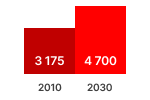 |
STOCK (x1000 units) 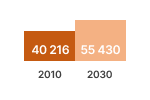 |
Electricity (TWh/a) 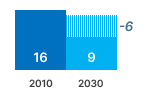 |
|
GHG-EMISSION  |
CONSUMER EXPENSES 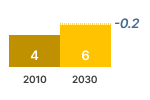 |
REVENUES 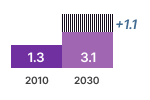 |
Source: estimations from the Ecodesign Impact Accounting Overview Report 2023
Expected Savings
EFFICIENCY AND ELECTRICITY
In 2020, TDs in EU27 consumed 10.5 TWh of electricity. Without measures, this would have decreased in 2040 to 8.1 TWh (due to the decrease in number of cycles per year and a limited replacement of air-vented tumble dryers by heat pump tumble dryers). With the new measures, which include demanding energy efficiency thresholds that can, currently, only be met by tumble dryers based on heat-pump technology, the 2040 consumption is expected to reduce to 7.0 TWh. The electricity savings represent a 13% improvement in 2040 compared to the situation without measures.
The heat pump tumble dryer was a major energy-saving innovation, whose commercial success was mainly due to the ambitious energy labelling scheme. In 2020, heat pump dryers consumed 1.2 kWh/cycle, compared to 3.0 kWh/cycle for vented electric dryers and condenser dryers with electric heating element.
Total EU27 Electricity Consumption of Laundry Dryers
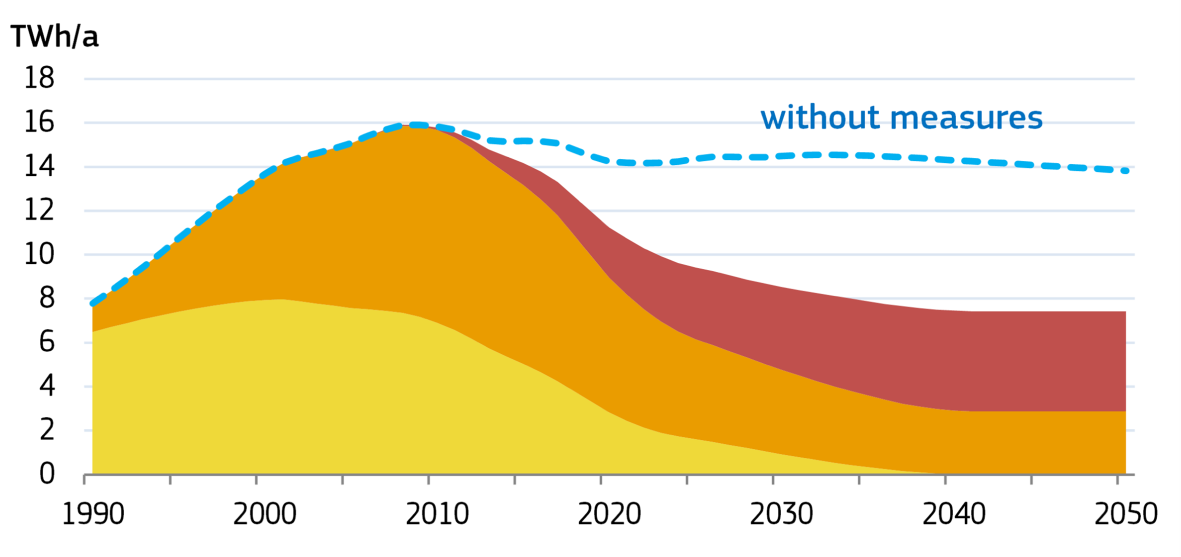

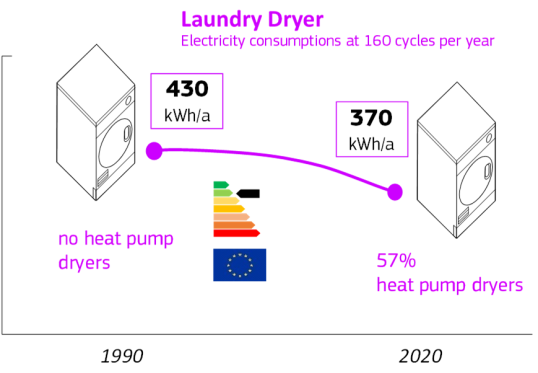
Source: estimations from the Ecodesign Impact Accounting Overview Report 2023

Suppliers
Suppliers shall ensure that:
(a) each household tumble dryer is supplied with a printed label in the format as set out in Annex III and, for a multi-drum household tumble dryer, in accordance with Annex X;
(b) the values for the parameters of the product information sheet, as set out in Annex V, are entered into the public part of the product database;
(c) where specifically requested by a dealer, the product information sheet is made available in printed form;
(d) the content of the technical documentation set out in Annex VI is entered into the product database;
(e) any visual advertisement concerning a specific model of household tumble dryer contains the energy efficiency class and range of energy efficiency classes available on the label in accordance with Annexes VII and VIII;
(f) any technical promotional material concerning a specific model of household tumble dryer, including technical promotional material on the internet, which describes its specific technical parameters, includes the energy efficiency class of that model and the range of energy efficiency classes available on the label, in accordance with Annex VII;
(g) an electronic label in the format and containing the information as set out in Annex III is made available to dealers for each model of household tumble dryer;
(h) an electronic product information sheet, as set out in Annex V, is made available to dealers for each model of household tumble dryer.

Dealers
Dealers shall ensure that:
(a) each household tumble dryer, at the point of sale, including at trade fairs, bears the label provided by suppliers in accordance with point (a) of Article 3(1), with the label being displayed for built-in appliances in such a way as to be clearly visible, and for all other appliances in such a way as to be clearly visible on the outside on the front or top of the household tumble dryer;
(b) in the event of distance selling, the label and product information sheet are provided in accordance with Annexes VII and VIII;
(c) any visual advertisement for a specific model of household tumble dryer, including on the internet, contains the energy efficiency class and the range of energy efficiency classes available on the label, in accordance with Annex VII;
(d) any technical promotional material concerning a specific model of household tumble dryer, including technical promotional material on the internet, which describes its specific technical parameters includes the energy efficiency class of that model and the range of energy efficiency classes available on the label, in accordance with Annex VII.

Policy
Ongoing legislative work
Please check the ongoing initiatives on the Have your say portal.
Commission Regulation (EU) 2023/2533 of 17 November 2023 implementing Directive 2009/125/EC of the European Parliament and of the Council with regard to ecodesign requirements for household tumble dryers Text with EEA relevance.
Regulation (EU) 2023/2534 of 13 July 2023 supplementing Regulation (EU) 2017/1369 of the European Parliament and of the Council with regard to energy labelling of household tumble driers.
Disclaimer: please pay attention to possible updates/changes as indicated in the Official Journal (green dot)


